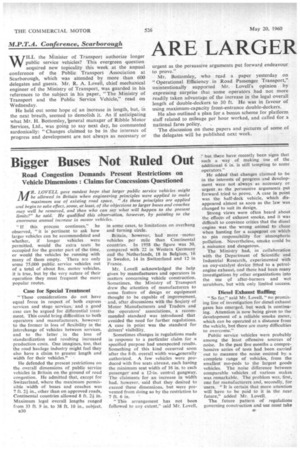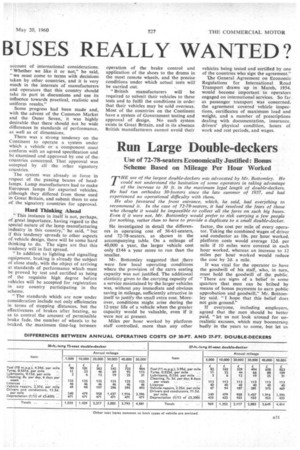.111.P.T.A. Conference, Scarborough
Page 64

Page 65

If you've noticed an error in this article please click here to report it so we can fix it.
ARE LARGER BUSES REALLY WANTED?
WILL the Minister of Transport authorize longer public service vehicles? This evergreen question acquired new topicality this week at the annual conference of the Public Transport Association at Scarborough, which was attended by more than 600 delegates and guests. Mr. R. A. Lovell, chief mechanical engineer of the Ministry of Transport, was guarded in his references to the subject in his paper, "The Ministry of Transport and the Public Service Vehicle," read on
Wednesday. .
He held out some hope of an increase in length, but, in the next breath, seemed to demolish it. As if anticipating what Mr. H. Bottomley, teneral manager of Ribble Motor Services, Ltd., was going to say next day, he commented sardonically: "Changes claimed to be in the interests of progress and development are not always as necessary or urgent as the persuasive arguments put forward endeavour to prove."
Mr. Bottomley, who read a paper yesterday on "Operational Efficiency in Road Passenger Transport," unintentionally supported Mr. Lovell's opinion by expressing surprise that some operators had not more readily taken advantage of the increase in the legal overall length of double-deckers to 30 ft. He was in favour of using maximum-capacity front-entrance double-deckers. He also outlined a plan for a bonus scheme for platform staff related to mileage per hour worked, and called for a national fares policy. .
The discussion on these papers and pictures of some of the delegates will be published next week.
account of international considerations. "Whether we like it or not," he said, " we must come to terms with decisions taken by other countries, and it is very much in the interests of manufacturers and operators that this country should take its part in discussions and use its influence towards practical, realistic and uniform results."
Some progress had been made and, with the advent of the Common Market and the Outer Seven, it was highly desirable that there should not be wide differences in standards of performance, as well as of dimensions.
There was a strong tendency on the Continent to operate a system under which a vehicle or a component must conform with an agreed specification and be examined and approved by one of the countries concerned. That approval was accepted by all the other signatory countries.
The system was already in force in respect of the passing beams of headlamps. Lamp manufacturers had to make European lamps for exported vehicles, although they differed from those used in Great Britain, and submit them to one of the signatory countries for approval.
Hard Thinking Ahead
"This instance in itself is not, perhaps, of great importance, having regard to the special nature of the lamp manufacturing industry in this country," he said, "but if this tendency spreads to other aspects of vehicle design, there will be some hard thinking to do. The signs are that this tendency will in fact spread.
"In addition to lighting and signalling equipment, braking is already the subject of close study, with the object of arriving at standards of performance which must be proved by test and certified as being of the requisite high degree before vehicles will be accepted for registration in any country participating in the scheme.
"The standards which are now under consideration include not only efficiencies in terms of stopping distances, but the effectiveness of brakes after heating, so as to control the amount of permissible brake fade, the number of wheels to be braked, the maximum time-lag between operation of the brake control and application of the shoes to the drums in the most remote wheels, and the precise conditions under which actual tests will be carried out.
British manufacturers will be required to submit their vehicles to these tests and to fulfil the conditions in order that their vehicles may be sold overseas. Most of the countries on the Continent have a system of Government testing and approval of design. No such system exists in Great Britain, and in its absence British manufacturers cannot avoid their vehicles being tested and certified by one of the countries who sign the agreement."
The General Agreement on Economic Regulations for International Road Transport drawn up in March, 1954, would become important to operators engaged on international services, So far as passenger transport was concerned, the agreement covered vehicle inspections, certificates of maximum load and weight, and a number of prescriptions dealing with documentation, insurance, drivers' physical condition, hours of work and rest periods, and wages.




















































































































